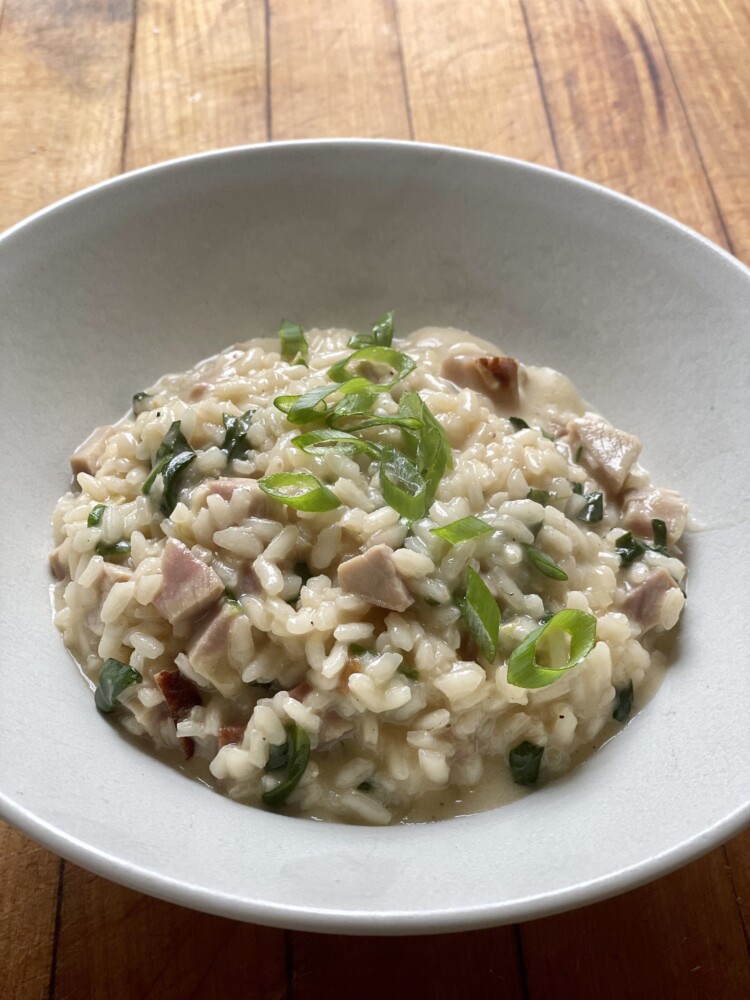I learned how to make risotto 30 years ago from Mary Ann Esposito, host of PBS’s “Ciao Italia,” the longest-running cooking show on TV. In the teaching kitchen of the Cambridge Center for Adult Education tucked behind Harvard Square, she taught me and a dozen other aspiring cooks the recipe for risi e bisi (rice and peas), a version of risotto made with the first peas of the season in the Veneto, a northern region of Italy where rice has been cultivated since the 16th century.
In the time that’s passed, I’ve made many, many pots of risotto. My favorites have included Maine wild mushroom, tomato and tiny mozzarella balls; and lobster and lemon. While no two have been the same, I follow the technical advice Esposito imparted that evening to pull off every single one of them.
That advice, as I recall, includes the following:
Use a heavy-bottomed pot so the low heat required for the process will be distributed evenly.
Dice alliums very small so they melt into the butter without burning.
Sauté short-grained rice (typically Arborio or Carnaroli) in fat so the grains separate from each other.
If you’re going to use wine, pick one you like to drink, because you can taste it in the dish.
Be sure the stock (which, like the wine, should taste good) you add to the simmering rice is warm.
Stir, stir and keep stirring.
Turn off the heat when the rice still has a bit of bite to it. The only way to know is to keep tasting the rice as you cook it.
Add cheese at the tail end of the process, and only if there is no seafood in play.
Taste for seasoning after you add the cheese.
Risotto served in warm bowls is always the way to go. (OK. I may have added that one because I really like to eat risotto while it’s hot.)

Leftover from Easter week, spinach, cheddar, scallions and ham become the ingredients for a sustainable risotto Photo by Christine Burns Rudalevige
Esposito made it clear, though, that while the technique for risotto remains constant, the recipes are endlessly adaptable to your taste, budget, and vegetable bin. Risotto, therefore, is an exceptional way to help curtail food waste in your kitchen.
The ingredient ratios must hold steady, of course. Two cups of rice require 6 cups of liquid to reach the creamy consistency of good risotto to serve four people. You need 6 tablespoons of butter, or olive oil and butter mix, per half cup of finely diced alliums (onions, shallots, leeks and such). Two cups of chopped add-ins – whether they are raw (zucchini or tomatoes), frozen (peas or broccoli), canned (artichokes or chickpeas) or already cooked (lobster meat or smoked sausage) – is enough. Any more than that, and the rice no longer plays the starring role, as it should.
As long as you hold to those ratios, you can use up any combination of extra vegetables, cooked meats, cheese ends and bits of herbs lying about in your fridge to create tonight’s risotto main course.
At the tail end of Easter week, I found myself with leftover locally smoked ham, a handful of spinach, some fine English cheddar, and three scallions whose greenery was getting a second life because the white roots sat in some water on my windowsill. Yes, I did indeed use an English cheddar in a traditional Italian risotto. Blasphemous? Possibly, but the resulting dish was delicious, not to mention environmentally and economically sustainable.

Warming the stock before adding it to the rice is among the rules of risotto-making. Photo by Christine Burns Rudalevige
WASTE-FREE HAM AND CHEESE RISOTTO
Risotto is best eaten as soon as it’s cooked. But day-old risotto can be formed into patties, coated lightly in bread crumbs and fried until the outside is crispy and the inside warmed through. Top these rice patties with a sunny side up egg.
Serves 2-4
4½ to 5 cups vegetable or chicken broth
6 whole scallions, trimmed
6 tablespoons butter
2 cups Arborio or Carnaroli rice
1 cup dry white wine
1 cup diced smoked ham
1 cup tightly packed, chopped, raw spinach
1/2 cup grated aged cheddar
Salt
Heat the broth in a 2-quart pot over low heat and keep warm while you make the risotto.
Cut the white and light green parts of the scallions from the dark green part. Finely dice the white and light green parts. Cut the greens thinly, on the diagonal.
Melt the butter in a 4-quart, heavy-bottomed pot over medium low heat. Add the diced white and light green parts of the scallion. Cook until the scallions are translucent, 3-4 minutes, but watch carefully that they do not brown. Stir in the rice and coat it well in butter. Raise the heat, add the wine and allow it to evaporate.
Add the warm broth, 1 ladleful at a time and allow the rice to absorb it before adding the next ladleful, stirring all the while. Add just enough of the remaining broth until the rice is cooked but still has a bit of a bite, 15-18 minutes. Stir in the ham, spinach, and all but 2 tablespoons of the sliced scallion greens. The spinach will cook in the hot risotto.
Stir in the cheese and salt to taste. Transfer the risotto to warm bowls and garnish with the remaining sliced scallion greens. Serve hot.
Send questions/comments to the editors.



Comments are no longer available on this story